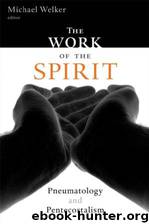The Work of the Spirit: Pneumatology and Pentecostalism by Michael Welker

Author:Michael Welker [Michael Welker]
Language: eng
Format: epub
Published: 2010-12-07T06:45:00+00:00
Pentecostals and Other Religious Movements
Finally, I wish to hazard a few thoughts about how early Pentecostals may help us understand the inner structure - the working DNA - of other popular religious movements, especially in modern America. I will focus on three points.
First of all, first-generation Pentecostals call us to remember what we easily forget: that real life is untidy. In their ability to hold seemingly incompatible impulses in productive tension, Holy Ghost folk dramatically exemplified that untidiness. And in their untidiness, they provide us with an almost test-tube perfect illustration of the need for supple historical methods. In the last twenty years, historians, seeking to capture the past's complexity, have elaborated an approach sometimes called the study of "lived religion." As the historian David D. Hall describes it, this approach deems practice - what people actually did, irrespective of what theologians, philosophers, editors, social scientists, and denominational officials think they ought to have done - as the vital, organizing center of religion. Rather than trying to smooth out or explain away the ambiguous, overlapping, or contradictory meanings that ordinary people ascribed to their experience, lived religion seeks to honor those meanings by taking them as its starting point. Beyond that, it esteems change and exchange. Recognizing the "time-bound shape of practice," lived religion assumes the likelihood of development over fixity and of contingency over inevitability. And it challenges unexamined assumptions about the inevitability of opposition between elite and popular, or between imposed and indigenous, or between core and periphery. It looks instead for signs of complicity, collaboration, and cross-fertilization.52
Lived religion does more than simply acknowledge the untidiness in religion, however. It also acknowledges that religion - untidy and otherwise - penetrates aspects of life that we conventionally regard as not religious at all, as perfectly mundane. Like traditional social histories of religion, lived religion looks beyond "official" texts (such as sermons, catechisms, and systematic theologies) to "unofficial" ones (such as sacred artifacts, missionary letters, and devotional lyrics). But unlike traditional social histories of religion, lived religion also tries to see how sacred sensibilities seeped into and colored everyday practices, sometimes supporting them, sometimes contesting them. In the words of the historian Julie Byrne - who, significantly, writes about religion and sports - lived religion follows the "fluid piety that always overflows official vessels."53 It searches for the evidences of faith in the midst of life, and of life in the midst of faith. Early Pentecostals give the practitioners of lived religion a lot to work on.
Second, early Pentecostals' story suggests that their distinctiveness - their angularity - enhanced rather than diminished their growth. It is important to remember that not all religious groups experience meaningful opposition. Some fit right in, all too well. My colleague Stanley Hauerwas likes to quip that long after Christianity is dead and gone, the United Methodist Church will still be flourishing. No one ever said that about Pentecostals. From the outset, Pentecostals' spiritual and in many cases biological parents marshaled impressive resources to crush the menace in their midst.
Download
This site does not store any files on its server. We only index and link to content provided by other sites. Please contact the content providers to delete copyright contents if any and email us, we'll remove relevant links or contents immediately.
The Lost Art of Listening by Michael P. Nichols(6496)
Why I Am Not A Calvinist by Dr. Peter S. Ruckman(3779)
The Rosicrucians by Christopher McIntosh(3062)
Wicca: a guide for the solitary practitioner by Scott Cunningham(2713)
Signature in the Cell: DNA and the Evidence for Intelligent Design by Stephen C. Meyer(2508)
Real Sex by Lauren F. Winner(2492)
The Holy Spirit by Billy Graham(2436)
To Light a Sacred Flame by Silver RavenWolf(2362)
The End of Faith by Sam Harris(2302)
The Gnostic Gospels by Pagels Elaine(2041)
Nine Parts of Desire by Geraldine Brooks(2011)
Waking Up by Sam Harris(1969)
Heavens on Earth by Michael Shermer(1961)
Devil, The by Almond Philip C(1910)
Jesus by Paul Johnson(1897)
The God delusion by Richard Dawkins(1861)
Kundalini by Gopi Krishna(1830)
Chosen by God by R. C. Sproul(1771)
The Nature of Consciousness by Rupert Spira(1695)
